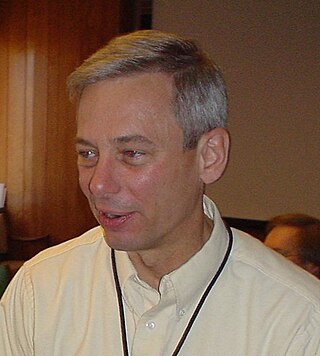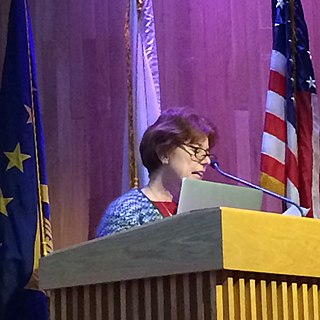Related Research Articles

The Relativistic Heavy Ion Collider is the first and one of only two operating heavy-ion colliders, and the only spin-polarized proton collider ever built. Located at Brookhaven National Laboratory (BNL) in Upton, New York, and used by an international team of researchers, it is the only operating particle collider in the US. By using RHIC to collide ions traveling at relativistic speeds, physicists study the primordial form of matter that existed in the universe shortly after the Big Bang. By colliding spin-polarized protons, the spin structure of the proton is explored.

Raymond Davis Jr. was an American chemist and physicist. He is best known as the leader of the Homestake experiment in the 1960s-1980s, which was the first experiment to detect neutrinos emitted from the Sun; for this he shared the 2002 Nobel Prize in Physics.

Roy F. Schwitters was an American physicist, professor of physics at Harvard, Stanford, and finally the University of Texas at Austin. He was also director of the Superconducting Super Collider between 1989 and 1993.

William Allen Zajc is a U.S. physicist and the I.I. Rabi Professor of Physics at Columbia University in New York, USA, where he has worked since 1987.

Richard Keith Ellis, is a British theoretical physicist, working at the University of Durham, and a leading authority on perturbative quantum chromodynamics and collider phenomenology.
Arie Bodek is an American experimental particle physicist and the George E. Pake Professor of Physics at the University of Rochester.

Gerald Edward Brown was an American theoretical physicist who worked on nuclear physics and astrophysics. Since 1968 he had been a professor at the Stony Brook University. He was a distinguished professor emeritus of the C. N. Yang Institute for Theoretical Physics at Stony Brook University.
Vernon Willard Hughes was an American physicist specializing in research of subatomic particles. Hughes was born in Kankakee, Illinois. During World War II, he worked at the M.I.T. Radiation Lab. He earned his PhD under I. I. Rabi at Columbia University in 1950. Hughes was notable for his research of muons which showed the existence of previously undetected matter. He was also noted for research that showed that protons have gluons and quarks. Hughes was a member of the National Academy of Sciences, Sterling Professor at Yale University, and a recipient of Rumford Prize, and a recipient of Davisson-Germer Prize in Atomic Physics and the Tom W. Bonner Prize in Nuclear Physics, both from the American Physical Society.

Barbara Jacak is a nuclear physicist who uses heavy ion collisions for fundamental studies of hot, dense nuclear matter. She is director of the Nuclear Science Division, Lawrence Berkeley National Laboratory, and a professor of physics at UC Berkeley. Before going to Berkeley, she was a member of the Department of Physics and Astronomy at Stony Brook University, where she held the rank of distinguished professor. She is a leading member of the collaboration that built and operates the PHENIX detector, one of the large detectors that operated at the Relativistic Heavy Ion Collider at Brookhaven National Laboratory, and was involved in the discovery of the quark gluon plasma and its strongly coupled, liquid-like behavior. Throughout her career she has served on many advisory committees and boards, including the National Research Council Committee on Nuclear Physics, and the Physical Review C editorial board.

Peter Jenni, is an experimental particle physicist working at CERN. He is best known as one of the "founding fathers" of the ATLAS experiment at the CERN Large Hadron Collider together with a few other colleagues. He acted as spokesperson of the ATLAS Collaboration until 2009. ATLAS is a world-wide collaboration which started in 1992 involving roughly 3,000 physicists at 183 institutions in 38 countries. Jenni was directly involved in the experimental work leading to the discoveries of the W and Z bosons in the 1980s and the Higgs boson in 2012. He is (co-)author of about 1000 publications in scientific journals.
Robert Graham Hamish Robertson is a Canadian–American experimental physicist, specializing in neutrino physics. He is a Professor Emeritus at the University of Washington, where he was formerly the director of the University of Washington's Center for Experimental Nuclear Physics and Astrophysics.
George F. Bertsch is an American nuclear physicist.
John Dirk Walecka, often quoted as J. Dirk Walecka is an American theoretical nuclear and particle physicist. He is a fellow of the American Physical Society and the author of numerous textbooks in physics. Walecka is currently the Governor's Distinguished CEBAF Professor of Physics, Emeritus at the College of William and Mary.
Iain William Stewart is a Canadian-American theoretical nuclear and particle physicist at the Massachusetts Institute of Technology, where he is the Otto and Jane Morningstar Professor of Science and the current Director of the MIT Center for Theoretical Physics (CTP). He is best known for his work on effective field theories and for developing the Soft Collinear Effective Theory (SCET).
Benson T. Chertok was professor of physics at The American University in Washington, D.C., a researcher in the field of high energy nuclear physics, and an advocate for arms control.
Geoffrey L. Greene is an American neutron physicist. Greene received his bachelor's degree from Swarthmore College in 1971 and his doctorate from Harvard University in 1974 with Norman Ramsey, a Nobel laureate in physics. There he worked on low-energy (cold) neutrons, which were then first available in intense beams. As a post-doctoral fellow he was at the Rutherford Appleton Laboratory and the Institut Laue-Langevin. He was an assistant professor at Yale University and then at the National Institute of Standards and Technology (NIST). He has held various management positions at Los Alamos National Laboratory. Since 2002, he is a professor at the University of Tennessee and Oak Ridge National Laboratory.
Joel Marshall Moss is an American experimental nuclear physicist.
Eric George Adelberger is an American experimental nuclear physicist and gravitational metrologist.
David William Hertzog is an American particle physicist, known for his research in precision muon physics.
Jen-Chieh Peng is an experimental nuclear physicist at the University of Illinois Urbana–Champaign.
References
- 1 2 3 "Wit Busza". MIT Department of Physics. Retrieved 3 June 2018.
- ↑ "MIT news". 26 October 2023.